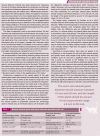Feline abdominal ultrasonography: what's normal? what's abnormal? The adrenal glands
- PMID: 33403910
- PMCID: PMC11163886
- DOI: 10.1177/1098612X20979509
Feline abdominal ultrasonography: what's normal? what's abnormal? The adrenal glands
Abstract
Practical relevance: Abdominal ultrasound plays a vital role in the diagnostic work-up of many cats presenting to general and specialist practitioners. Ultrasound examination of the adrenal glands can provide important information pertaining to several conditions including hyperaldosteronism and hyperadrenocorticism.
Clinical challenges: Despite ultrasonography being a commonly used modality, many practitioners are not comfortable performing an ultrasound examination or interpreting the resulting images. Even for the experienced ultrasonographer, differentiating between incidental findings, such as adrenal mineralisation, and clinically significant pathological changes can be challenging.
Aim: This review, part of an occasional series on feline abdominal ultrasonography, discusses the ultrasonographic examination of the normal and diseased adrenal glands. Aimed at general practitioners who wish to improve their knowledge of and confidence in feline abdominal ultrasound, this review is accompanied by high-resolution images and videos available online as supplementary material.
Equipment: Ultrasound facilities are readily available to most practitioners, although the use of ultrasonography as a diagnostic tool is highly dependent on operator experience.
Evidence base: Information provided in this article is drawn from the published literature and the author's own clinical experience.
Keywords: Ultrasound; acromegaly; adrenal mineralisation; hyperadrenocorticism; hyperaldosteronism; hyperthyroidism; hypoadrenocorticism; phaeochromocytoma.
Conflict of interest statement
The author declared no potential conflicts of interest with respect to the research, authorship and/or publication of this article.
Figures
















References
-
- Tidwell AS, Penninck DG, Besso JG. Imaging of adrenal gland disorders. Vet Clin North Am Small Anim Pract 1997; 27: 237–254. - PubMed
-
- D’Anjou MA, Penninck D. Adrenal glands. In: D’Anjou MA, Penninck D. (eds). Atlas of small animal ultrasonography. Iowa: John Wiley & Sons, 2015, pp 387–401.
-
- Zimmer C, Horauf A, Reusch C. Ultrasonographic examination of the adrenal gland and evaluation of the hypophyseal-adrenal axis in 20 cats. J Small Anim Pract 2000; 41: 156–160. - PubMed
-
- Nyland TG, Neelis DA, Mattoon JS. Adrenal glands. In: Mattoon JS, Nyland TG. (eds). Small animal diagnostic ultrasound. 3rd ed. St Louis, MO: Saunders, 2015, pp 541–556.
Publication types
MeSH terms
LinkOut - more resources
Full Text Sources
Other Literature Sources
Medical
Miscellaneous

